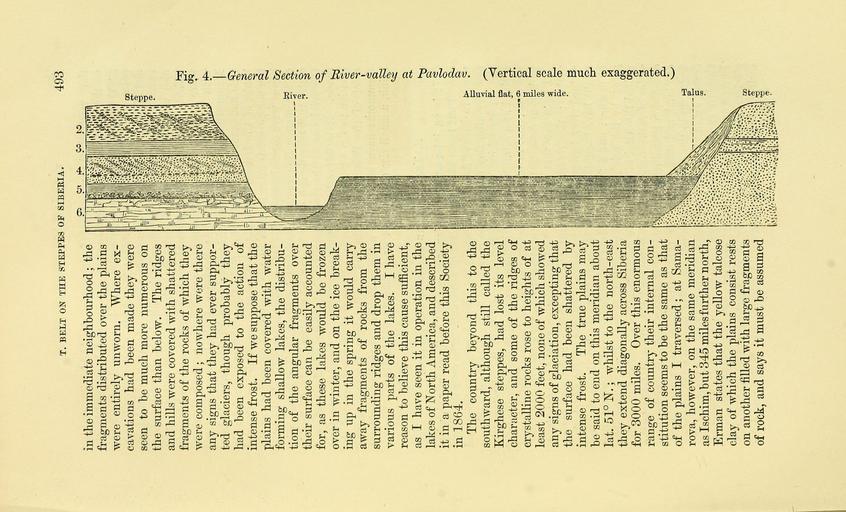MAKE A MEME
View Large Image

| View Original: | The_Quarterly_journal_of_the_Geological_Society_of_London_(12733932495).jpg (3200x1936) | |||
| Download: | Original | Medium | Small | Thumb |
| Courtesy of: | commons.wikimedia.org | More Like This | ||
| Keywords: The Quarterly journal of the Geological Society of London (12733932495).jpg 494 T BELT ON THE STEPPES OF SIBERIA <br> that west of the meridian of Samarova the blocks lie exposed <br> on the surface whilst eastward they are completely covered by the <br> great deposit of clay; two thousand miles to the eastward of this <br> point at Yakutsk he states that the strata of the steppes con- <br> sist of loam fine sand and magnetic sand In the deepest parts <br> twigs and leaves of trees are found ; the alluvial plain of the Lena <br> also consists of similar deposits and the spoils of willow-banks <br> Everywhere he says throughout these immense alluvial deposits <br> there are now lying the bones of antediluvian quadrupeds along <br> with vegetable remains At Pavlodav I obtained teeth of the <br> Mammoth and Rhinoceros tichorinus from M Hermann Paulson <br> who had made a large collection of the bones of Mammalia from the <br> banks of the Irtisch He told me they were exposed in sections of <br> the steppe-sands after freshets in the spring when portions of the <br> banks were carried away ; this information agrees with the position <br> of the mammalian remains assigned by the traveller Pallas who <br> states that they do not occur in the marshes or low lands but in <br> the precipices of the river-banks in what I have called the steppe- <br> sands It is interesting to find that they are found in the same <br> position as the Cyrena fluminalis Further to the north around the <br> coast of the Polar sea within the Arctic circle the carcasses of <br> mammoths have been found along with marine shells proving I <br> think a small rise of the coast since they were deposited <br> 2 Theory of the Origin of the Steppes <br> It is an interesting question and one not easily answered what <br> spread out these vast level sheets of sand and loam over the whole <br> northern base of Asia For weeks as I was driven over them and <br> saw day after day the sun rise on a level horizon and set again on <br> the far-stretching plains I puzzled myself with it I ultimately <br> arrived at a solution which I believe meets all the requirements of <br> the case ; and to obtain its acceptance by geologists I think it will <br> be best to describe the steps by which I was led to it <br> I soon saw that the plains had no relation to the present river- <br> system the rivers simply cut through them ; and there are no <br> defined river-basins bounded by rocks of greater age B in which they <br> might have been deposited My next idea was that the sands must <br> be marine ; and I find that this is the explanation of their formation <br> given by the celebrated geologist Prof Bernhard von Cotta who <br> visited the Altai in 1868 He states that the absence of the entire <br> series of rocks between the Permian and the Diluvial leads to the <br> conclusion that during the whole of this long period the region was <br> dry land and that during the Diluvial period it was covered with <br> water up to the foot of the mountains He says at this time an <br> ocean extending from the' Glacial Sea to the Ural the Altai and the <br> Caspian and Black Seas seems to have been a boundary between <br> Europe and the south and east of Asia The absence of traces of <br> glaciers and indeed generally of any vestiges of a glacial period <br> such as are so frequently observed in Europe may be accounted for 35766415 110599 51125 Page 493 Text v 30 http //www biodiversitylibrary org/page/35766415 1874 Geological Society of London NameFound Cyrena fluminalis NameConfirmed Cyrena fluminalis NameFound Mammalia NameConfirmed Mammalia EOLID 15503955 NameBankID 2478620 Biodiversity Heritage Library The Quarterly journal of the Geological Society of London v 30 1874 Geology Periodicals Smithsonian Libraries bhl page 35766415 dc identifier http //biodiversitylibrary org/page/35766415 smithsonian libraries Information field Flickr posted date ISOdate 2014-02-24 Check categories 2015 August 26 CC-BY-2 0 BioDivLibrary https //flickr com/photos/61021753 N02/12733932495 2015-08-26 19 52 37 cc-by-2 0 PD-old-70-1923 The Quarterly journal of the Geological Society of London 1874 Photos uploaded from Flickr by Fæ using a script | ||||